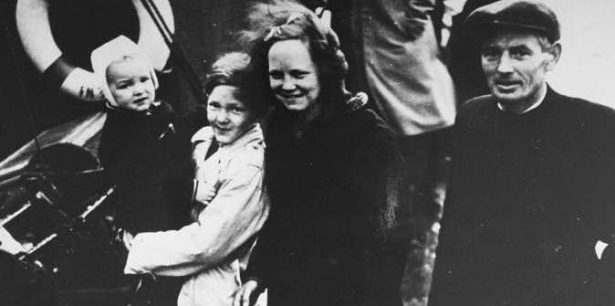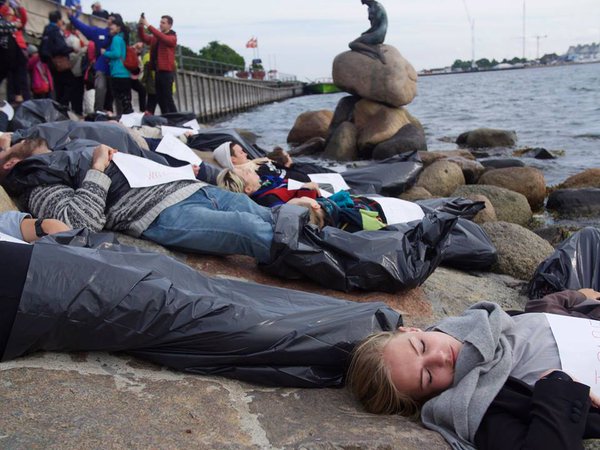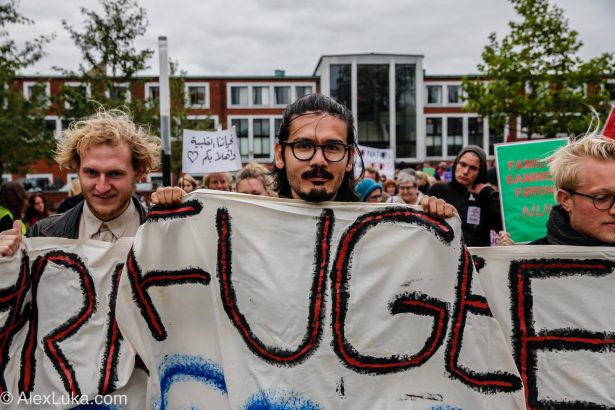The article below, reproduce from Wagingnonviolence.org opens interesting discussions on how to use legal breach for campaigning purposes.
Applied to LGBTI, this tactics of explicitly and visibly transgressing the law you want to see abolished has been used quite extensively in times and places where anti-LGBTI laws were still on the books but not enforced. This is somewhat different to strategic litigation cases,where you challenge a law in a legal battle, but can be combined.
This issue is certainly worth opening a chapter on.
—————
About 100 Danes, young and old, stood outside Copenhagen City Court in the chilly seaside winds last Tuesday to show their solidarity with four activists alleged to have illegally assisted refugees in their trek across the waters from Denmark to Sweden.
While only two of the accused are Danish citizens, all are members of MedMenneskeSmuglerne, or “Those who smuggle thy neighbor” — an outgrowth of the more broad-based initiative Welcome to Denmark, which welcomes migrants and refugees into the country.
Last year, over one million migrants and refugees from Syria, Afghanistan, Eritrea and other unstable nations endured the risks of exodus to Denmark and other parts of Europe. Many died during the journey or ended up in refugee camps for prolonged periods. This migration wave correlates directly to the growing xenophobia and shift to the right in many European countries, including Denmark.
“Pretty much all leftist organizations in Europe neglected to consider the refugee influx on their agendas,” said Mimoza Murati, one of the non-Danish activists facing criminal charges that day. “We should have been prepared because we know the political landscape.”
While Danish prosecutors may not have agreed, their case was ultimately dismissed for lack of substantial evidence. The four members of MedMenneskeSmuglerne were met with victorious applause by their Welcome to Denmark cohorts outside the court building.
Providing hospitality for asylum seekers
When Trine Simmel, a young Danish activist from Aarhus, saw the masses of migrants on television pouring across the German border into Denmark’s Jylland peninsula around September 2015, she connected with her friends to figure out what they could do to provide basic needs to the newcomers.
The migrants were being escorted by policemen into Jylland, so the youth initially planned to wait at an overpass, where they could drop care packages full of warm clothes, hygiene products and other essentials. The migrants, however, had become suspicious of being escorted by state authorities and dispersed themselves into the forests, which made tracking them much more difficult.
“The young people residing in Jylland called their parents to convene four or five cars, so shoes and related items could be distributed,” Simmel explained. “When drivers would come across migrants, they would offer the care package and ask them where they wanted to go within Denmark.”
A good number of the refugees decided to go to Copenhagen, just across the sea from Sweden, where some already had family members.
“Many apolitical people stepped up to help drive those walking on the railways,” Simmel said. “Many of these people had family backgrounds as immigrants and felt empathetic, but were not usually active in political issues.” An informal hospitality network known as Venligboerne, which includes over 150,000 members across Denmark, helped facilitate the volunteer effort.
Activists like Simmel felt this crisis presented an opportunity to get away from the typical activist duties of meetings and demonstration, and provide a direct service. The influx of refugees tugged at their consciences.
“Just like my grandfather, I had to decide which side of history I wanted to be on,” Simmel said. “Politicians demonized us for posting pictures on Facebook of immigrants being helped, but even [Danes] during World War II were demonized and in violation of the law [for helping Jews].”
Reviving a tradition of refugee smuggling
Denmark was the only country in Europe to reduce the size of its armed forces at the beginning of WWII, yet it was undoubtedly among the most effective in resisting German occupation.
Shortly after an overnight invasion of Denmark on April 9, 1940, 17-year-old Slagelse schoolboy Arne Sejr became frustrated at Danish passivity toward foreign rule. He returned home from school and used his typewriter to print 25 copies of his“Ten Commandments for Danes.” The last of these commandments read, “You shall protect anyone chased by the Germans.”
Danish youth discretely produced fliers of this kind over the course of the German occupation. Groups like the Danish Youth Association under the guidance of theology professor Hal Koch and the Churchill Club in Alborg sabotaged German authorities on a regular basis, sometimes destroying vehicles carrying weapons and munitions.
Christian communities circulated messages against the German occupation through their homilies. This led to the murder of Kaj Munk, who was among the most outspoken clerics advocating for Danish self-rule.

Among all of the tactics employed, the WWII-era Danes are perhaps most remembered for their effective smuggling of refugee Jews across the border into Sweden. During the course of a few months in 1943, 7,220 Jews — almost the entire Jewish population in Denmark — managed to escape to Sweden with the help of their Danish comrades. Only 472 were captured in early October during raids by the Nazis.
“Early on, we used this history of direct service to refugees as our inspiration,” said Welcome to Denmark organizer Søren Warburg.
Providing a warm bed, an underground route to Sweden, warm clothes and a key to one’s house: These are tactics literally cut from WWII memory and pasted upon today’s context of migration in Europe. Even while Denmark’s present government has intentionally made itself unattractive to asylum seekers, Danes themselves — strengthened by a history of unions and community organizing — are providing the services their elected representatives in the welfare state are refusing to provide.
Reflecting on the history of Danish aid to Jewish refugees, Welcome to Denmark spokesperson Line Søgaard said, “We had a sense that something historical was happening again.” According to her, 500 Danes initially responded to the call to action and formed working groups, focusing both on a political campaign and direct services.
Sailing in solidarity
Since Copenhagen is situated about 20 miles across the Öresund Strait from Malmö, Sweden, members of the sailing community who wanted to help refugees find family members or friends in Sweden decided to take action. In October of 2015, they gathered a list of nearly 20 names of allied boat owners and organized the transport of migrants as a public act of defiance.
“At the beginning, we did not think anyone was going to get prosecuted,” Søgaard said. “There are real human traffickers they could go after, but instead leaders are saying that we are the ones betraying the nation.”
Getting in a boat again is no easy task for refugees who have survived the crossing of the Mediterranean Sea. “Many of the migrants we helped to reach Sweden would send us audio messages once they were relieved to have reached their family members,” Søgaard said. “There was this sense that we were continuing the [WWII] legacy of assisting refugees, which some of our family members had started. We had stuck to our sense of morals and ethics even when the [anti-smuggling] law is wrong.”
Crossing by sea, however, wasn’t the only way to reach Sweden. Calle Vangstrup, one of the other four activists who faced criminal charges, worked with his movement members to provide around-the-clock assistance at Rødby, Padborg and Central stations — three major meeting points where migrants who are usually not conversant in Danish or able to understand the transportation system could depart for Sweden by train.
“There were groups of people who were willing to help within the law and those willing to break the law [prohibiting transportation assistance across the border],” Vangstrup said. “Thankfully, the Swedes are more receptive these days, unlike during WWII when they would often send the smuggled Jews back and put them at risk again.”
Vangstrup believes members of Danish Nazi groups and the populist Danish Peoples’ Party were the ones who saw MedMenneskeSmuglerne on the news and reported them to the police.
“As a socialist and as a human being, I feel I should not enjoy so many rights when the refugees have none,” Vangstrup said.
Although the police carried out investigations leading to the charges against Vangstrup and his fellow activists last spring, police have not always perpetuated the xenophobia that characterizes the growing right-wing political ideology of Denmark.
During WWII, thousands of police officers were arrested by German authorities. Danish cops had developed a reputation for being unreliable, often deliberately overlooking the acts of sabotage committed by Danish youth against the occupiers.
This kind of humanity among the police resurfaced during the recent migrant influx in Denmark. “Many people were asking police what they could do to help the refugees,” Søgaard said. “The police did not even know how to advise people, so some looked the other way as the transporters continued their work.”
After the four activists accused of human trafficking were relieved of their charges, they spoke at a press conference, encouraging those directly aiding migrants and refugees to continue their work.
“We are not even a radical group,” Søgaard said. “We are just saying the same things that groups like the United Nations are saying [about the migration crisis]. Yet, there is still resistance to our efforts.” At the end of the day, these so-called human traffickers were just helping others in need with a lift to wherever they were going.
“We all have a right to security and a safe place for us and our children,” she continued. “We can’t just close up our borders and live comfortable lives.”








